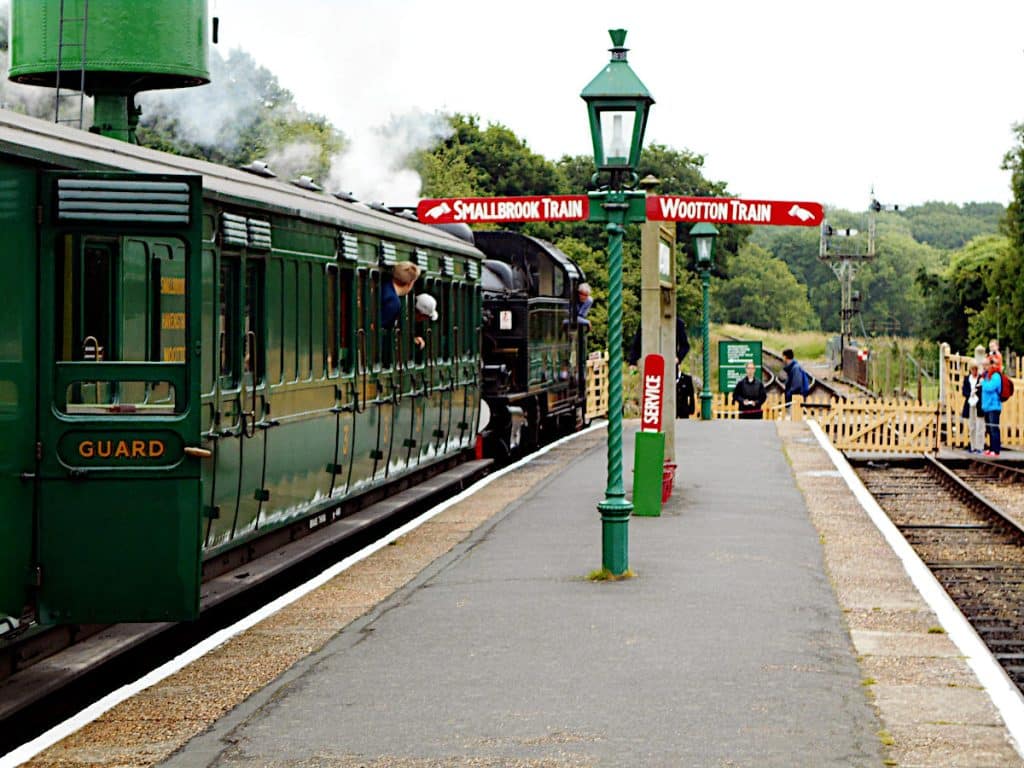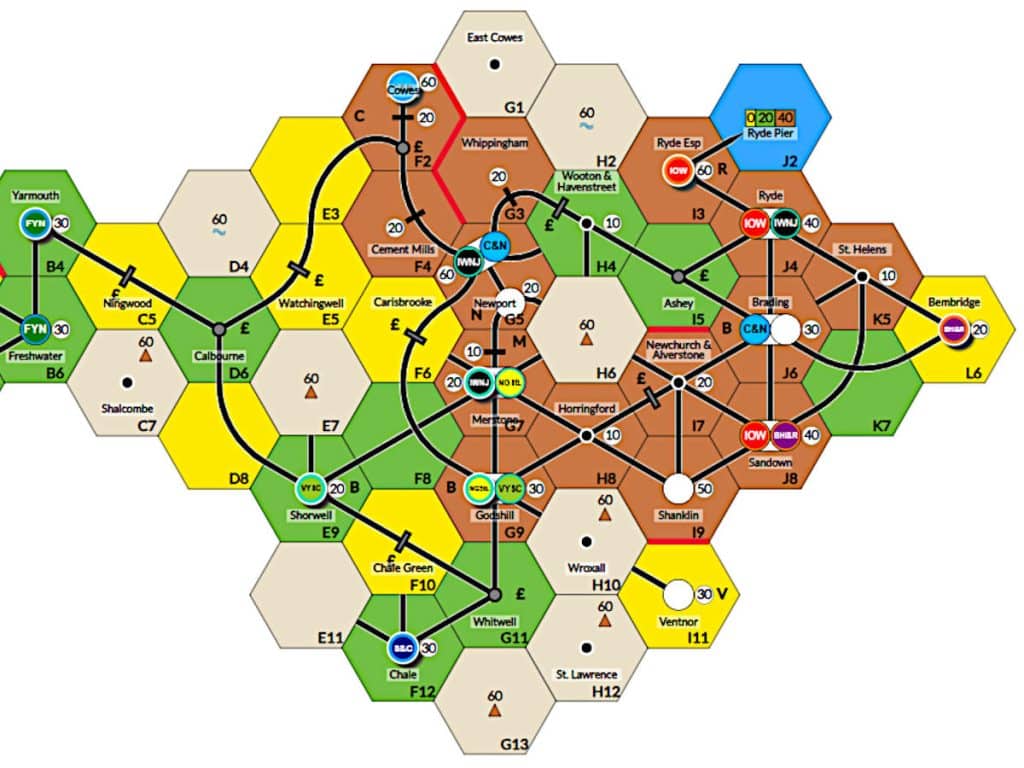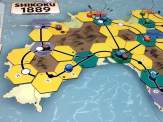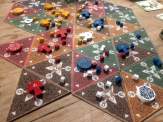| Release Date: 2004 | Players: 2-4 |
| Designer: Mike Hutton | Length: 180-240 minutes |
| Artist: n/a | Age: 16+ |
| Publisher: All-Aboard Games | Complexity: 4.0 / 5 |
| Plastic (by weight): unknown | Air (by volume): unknown |
In response to Queen Victoria’s love of Osborne House, railways were built that ran from Cowes to Newport and from Ryde to Ventnor. As if to underline the significance of the project, two rival companies, the LSWR and LBSC, collaborated to create a train network that was soon hailed as a triumph of public service over profitability and that ran from Ryde to Ventnor, Freshwater to Newport, Cowes to Ryde via Newport, Newport to Sandown and Merstone to Ventnor. All of this happened in 1860: Railways on the Isle of Wight by Mike Hutton from All-Aboard Games.
Listen to the Audio Version
Intro Music: Bomber (Sting) by Riot (https://www.
Sound Effects: bbc.co.uk – © copyright 2025 BBC
Music I Use: Bensound.com/free-music-for-videos
License code: CILZ3MAE6USRDRHR
1860’s Historic Setting vs. The Game
I love how the rulebook for 1860, as I’m going to call it for short, goes into the history of the Isle of Wight rail network. As I hinted at in the introductory paragraph, the railways on the Isle of Wight began in the 1860s, driven partly by Queen Victoria’s fondness for Osborne House. Despite the bitter rivalry between the LSWR and LBSC, both companies collaborated to build early lines. These included routes from Cowes to Newport and Ryde to Ventnor. Over time, a patchwork of local railways emerged, which eventually covered much of the eastern and central parts of the island. However, the island’s rugged southwest remained unconnected due to difficult terrain and low demand, despite plans in the 1880s that never materialised.
Operating railways on the island was always financially challenging. Materials had to be imported from the mainland, the geology posed engineering problems, and passenger traffic was often seasonal. Several companies failed before WWI, with the Freshwater, Yarmouth & Newport Railway famously going bankrupt twice, even though it continued operations.
Much of the network survived under the Southern Railway in the 1920s but faced closure after nationalisation due to rising costs and bus competition. Today, only the eastern Ryde line remains in commercial use, while a preserved section between Newport and Ryde operates as a heritage railway from Havenstreet.
At the same time, the game makes it clear that this is not a simulation of history.
The network players are likely to build during the game is much larger than the lines that were actually built. Yet, all of the stations that were part of the real-life network are present in the game, including some villages that never got connected to the network.
Additionally, all but two of the companies featured in the game are taken from history.

18xx Differences
The biggest difference between 1860 and other 18xx games is definitely the size of the map. It’s much smaller, and additionally, its topography is relatively unique. The various chines force trains to snake around the island. While other games also feature hard borders that cut through the map, given the small size of the 1860 map, these boundaries feel especially tough to deal with. The smaller size also forces players into close contact early on. In 1860 you don’t really have any choice but to join forces.
Another big difference from other 18xx games is the nationalisation mechanism at the end of the game, where the weakest companies are removed from the game until only healthy and stable routes remain. That encourages players to build companies that have a regular, steady income and can support themselves long term.
There are a few more differences worth mentioning.
In 1860, players can own 100% of a company, which creates a weird dynamic that steers players to invest in every train company, even if it’s only for 10%. Not only that, in 1860, you can also sell your president’s share back to the bank. At that point, the company goes into receivership and continues to operate until someone buys the president’s share back.
Additionally, companies are never required to own trains, which means players can never go bankrupt. Instead, the company becomes insolvent and is forced to lease a train based on the current phase. All earnings are withheld until a train is bought.
Finally, you are allowed to run a route through one, and only one, tokened-out city once per operating round, which means strategic route building and station placement are very important.
The 1860s Were Tough
If you played other 18xx games before, you can probably see how tough 1860 feels. Your companies never do particularly well. Every turn you’re eeking out your meagre existence in the hope that you can keep the trains running until the end. It never feels like you’re getting anywhere. There is never a runaway player. Everyone is quite close until near the end, when weaker companies are nationalised and exit the game, while the stronger companies get a few extra operating rounds. Only then does it become clear who is going to win.
That makes playing 1860 a really nice experience. There is no risk of players going bankrupt. Breaking the bank is also impossible. Everyone knows that they are in it for the long run. Even if you plan badly, you can always recover. 1860 is a very forgiving game compared to many of its 18xx compatriots.
Yet, it also feels quite cut-throat. With the map being quite small and the topography making route building a challenge, players quickly end up connecting tracks, opening up new opportunities for each other. It never feels great to allow other players to benefit from your track laying, but somehow it’s the only way forward on this tough island. You don’t regret helping each other quite so much as you do in other 18xx games.
At the same time, it is possible to slow other players down while helping yourself. If you make sure you place or upgrade the right track at the right time, and put the same careful consideration into your station placement, you can easily lock out other players from beneficial routes. It’s just a bit trickier in 1860, because you can go through one tokend-out city, but it is possible and becomes easier the more often you play.

1860‘s Conclusion
I do really love 1860. It’s a quicker game, even though it still takes a few hours and even though time seems to slow down as you play it, because every decision, at least in the mid game, is important and needs thought. I guess it’s quite fitting, because I’m sure Queen Victoria also felt the slow pace of the Isle of Wight when she visited.
You don’t have to worry about tiles running out. While trains are important in 1860, it’s not the end of the world if yours rust and you don’t have money to buy new ones. You still make all the same decisions as in other 18xx games, but it’s less punishing in many ways and more forgiving, while it’s always tough to make any progress. It’s a really weird pace that the game sets, but one I really enjoy.
You have to forget some of the strategies you’re used to from other 18xx games if you want to do well in 1860. The focus really is on building up companies that are solid. You want to create a steady income stream. There is no need to fight for the biggest profit all the time, because if your routes aren’t profitable, your company will be nationalised. Be the turtle and outpace the hare.
I will always be happy to play 1860. So far, I’ve only played it digitally on 18xx.games, so I can’t comment on the component quality of physical copies, but I can assure you the gameplay experience itself is amazing and feels very different to so many other 18xx games, while also being very familiar. It’s almost a cosy 18xx game that will give you warm feelings and leave you feeling exhausted, but also very satisfied.
This blog is free for everyone, but if you'd like to support it, here are some options.
Useful Links
- 1860: Railways on the Isle of Wight: https://all-aboardgames.
com/ products/ international-1860-railways-on-the-isle-of-wight - Rulebook: https://boardgamegeek.
com/ filepage/ 238952/ third-edition-rules - Rules video: https://youtu.
be/ tb8DpmU0JrE? si= 0gUdS68QBy_ AOmJQ - All-Aboard Games: https://all-aboardgames.
com/ - BGG listing: https://boardgamegeek.
com/ boardgame/ 12750/ 1860-railways-on-the-isle-of-wight - 18xx.games: https://18xx.
games/
Videos
Transparency Facts
I feel that this review reflects my own, independent and honest opinion, but the facts below allow you to decide whether you think that I was influenced in any way. Please also read my Ethics Statement for more information.- I played a freely available online copy of the game.
- At the time of writing, I have not received financial support from the publisher or anyone working on their behalf.
Audio Version
Intro Music: Bomber (Sting) by Riot (https://www.
Sound Effects: bbc.co.uk – © copyright 2025 BBC
Music I Use: Bensound.com/free-music-for-videos
License code: CILZ3MAE6USRDRHR
Playlist
These are the songs I listened to while I was writing this review:






